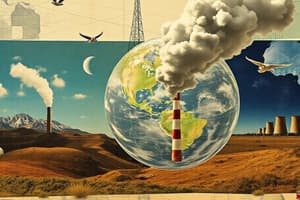Podcast
Questions and Answers
What distinguishes PM10 from PM2.5?
What distinguishes PM10 from PM2.5?
- PM10 is less harmful than PM2.5.
- PM2.5 consists of particles smaller than 2.5 micrometers. (correct)
- PM2.5 is mainly composed of lead particles.
- PM10 includes particles larger than 10 micrometers.
Which gas is primarily formed by chemical reactions between pollutants and sunlight?
Which gas is primarily formed by chemical reactions between pollutants and sunlight?
- Sulfur Dioxide
- Nitrogen Dioxide
- Ground-level Ozone (correct)
- Carbon Monoxide
What is the primary health concern associated with Carbon Monoxide exposure?
What is the primary health concern associated with Carbon Monoxide exposure?
- Reduced oxygen supply to the body's organs (correct)
- Increased cholesterol levels
- Skin irritation
- Respiratory infections
Which of the following pollutants is known to contribute to acid rain?
Which of the following pollutants is known to contribute to acid rain?
What is a health effect of Nitrogen Dioxide exposure?
What is a health effect of Nitrogen Dioxide exposure?
What is the primary function of the atmosphere in relation to Earth?
What is the primary function of the atmosphere in relation to Earth?
Which layer of the atmosphere is primarily responsible for weather phenomena?
Which layer of the atmosphere is primarily responsible for weather phenomena?
What are greenhouse gases mainly responsible for?
What are greenhouse gases mainly responsible for?
Which gas is considered most significant for its role in climate change?
Which gas is considered most significant for its role in climate change?
What is particulate matter, and why is it a concern for air quality?
What is particulate matter, and why is it a concern for air quality?
What is the primary function of the ozone layer found in the stratosphere?
What is the primary function of the ozone layer found in the stratosphere?
What happens to temperature as altitude increases in the stratosphere?
What happens to temperature as altitude increases in the stratosphere?
What characterizes the weather activity in the stratosphere?
What characterizes the weather activity in the stratosphere?
In which atmospheric layer do meteors burn up, creating shooting stars?
In which atmospheric layer do meteors burn up, creating shooting stars?
What occurs in the thermosphere due to the absorption of high-energy solar radiation?
What occurs in the thermosphere due to the absorption of high-energy solar radiation?
What natural phenomena can be observed in the thermosphere?
What natural phenomena can be observed in the thermosphere?
What is a major form of air pollution that can be found in gaseous forms?
What is a major form of air pollution that can be found in gaseous forms?
What is created from particulate matter (PM) in air pollution?
What is created from particulate matter (PM) in air pollution?
What is the size of particulate matter pollutants?
What is the size of particulate matter pollutants?
Which of the following can particulate matter pollutants be composed of?
Which of the following can particulate matter pollutants be composed of?
How are secondary pollutants produced?
How are secondary pollutants produced?
Which statement is true about particulate matter pollutants?
Which statement is true about particulate matter pollutants?
What defines particulate matter pollutants?
What defines particulate matter pollutants?
Which of the following is NOT a characteristic of particulate matter pollutants?
Which of the following is NOT a characteristic of particulate matter pollutants?
Which two components interact to produce secondary pollutants?
Which two components interact to produce secondary pollutants?
Which of the following statements is false regarding particulate matter pollutants?
Which of the following statements is false regarding particulate matter pollutants?
What are Criteria Pollutants?
What are Criteria Pollutants?
What is a major health effect associated with Particulate Matter (PM)?
What is a major health effect associated with Particulate Matter (PM)?
Why are some air pollutants subject to strict regulation?
Why are some air pollutants subject to strict regulation?
Which of the following is NOT considered a Criteria Pollutant?
Which of the following is NOT considered a Criteria Pollutant?
How does Particulate Matter primarily affect humans?
How does Particulate Matter primarily affect humans?
Which of the following best describes Particulate Matter?
Which of the following best describes Particulate Matter?
What is a possible environmental effect of air pollution?
What is a possible environmental effect of air pollution?
What is one of the primary sources of air pollution affecting humans?
What is one of the primary sources of air pollution affecting humans?
Which compounds are released into the atmosphere from burning fossil fuels or biomass?
Which compounds are released into the atmosphere from burning fossil fuels or biomass?
What role do nitrogen oxides (NOx) play in ozone formation?
What role do nitrogen oxides (NOx) play in ozone formation?
What type of pollution is primarily generated by vehicles and industry?
What type of pollution is primarily generated by vehicles and industry?
Which of the following processes produces one molecule of ozone?
Which of the following processes produces one molecule of ozone?
What do hydrocarbons react with during the process of photooxidation?
What do hydrocarbons react with during the process of photooxidation?
What is a direct result of the oxidation of one carbon monoxide molecule?
What is a direct result of the oxidation of one carbon monoxide molecule?
Which of the following is NOT a source of the pollutants mentioned?
Which of the following is NOT a source of the pollutants mentioned?
Which two pollutants primarily lead to urban ozone formation?
Which two pollutants primarily lead to urban ozone formation?
Flashcards
Particulate matter
Particulate matter
Tiny particles of solid or liquid substances, less than 10 micrometers in diameter.
Primary pollutants
Primary pollutants
Pollutants that are directly released into the air from sources like factories or cars.
Secondary pollutants
Secondary pollutants
Pollutants that are formed in the atmosphere through chemical reactions between primary pollutants, sunlight, and natural gases.
Particulate matter size
Particulate matter size
Signup and view all the flashcards
Particulate matter composition
Particulate matter composition
Signup and view all the flashcards
Health effects of particulate matter
Health effects of particulate matter
Signup and view all the flashcards
Sunlight and secondary pollutants
Sunlight and secondary pollutants
Signup and view all the flashcards
Natural gases and secondary pollutants
Natural gases and secondary pollutants
Signup and view all the flashcards
Stratosphere
Stratosphere
Signup and view all the flashcards
Ozone Layer
Ozone Layer
Signup and view all the flashcards
Temperature Inversion in the Stratosphere
Temperature Inversion in the Stratosphere
Signup and view all the flashcards
Mesosphere
Mesosphere
Signup and view all the flashcards
Meteors Burning in the Mesosphere
Meteors Burning in the Mesosphere
Signup and view all the flashcards
Thermosphere
Thermosphere
Signup and view all the flashcards
International Space Station Location
International Space Station Location
Signup and view all the flashcards
Aurora Borealis and Australis
Aurora Borealis and Australis
Signup and view all the flashcards
Ground-level ozone
Ground-level ozone
Signup and view all the flashcards
Carbon monoxide
Carbon monoxide
Signup and view all the flashcards
Sulfur dioxide
Sulfur dioxide
Signup and view all the flashcards
Nitrogen dioxide
Nitrogen dioxide
Signup and view all the flashcards
Particulate matter (PM)
Particulate matter (PM)
Signup and view all the flashcards
Criteria pollutants
Criteria pollutants
Signup and view all the flashcards
Role of sunlight in secondary pollutant formation
Role of sunlight in secondary pollutant formation
Signup and view all the flashcards
Photochemical Smog
Photochemical Smog
Signup and view all the flashcards
Ozone Formation
Ozone Formation
Signup and view all the flashcards
Photooxidation of Hydrocarbons
Photooxidation of Hydrocarbons
Signup and view all the flashcards
Oxidation Reactions
Oxidation Reactions
Signup and view all the flashcards
Combustion of Fossil Fuels and Biomass
Combustion of Fossil Fuels and Biomass
Signup and view all the flashcards
Oxidation of Carbon Monoxide
Oxidation of Carbon Monoxide
Signup and view all the flashcards
Study Notes
Intended Learning Outcomes (ILOs)
- Explain the composition of the atmosphere
- Discuss major air pollutants and their sources
- Discuss greenhouse gases and the greenhouse effect
Atmospheric Composition
- Earth's atmosphere is about 78.08% nitrogen, 20.95% oxygen, and 0.93% argon
- Trace gases make up approximately 0.04%, including greenhouse gases like carbon dioxide, methane, nitrous oxide, and ozone
- Water vapor concentration varies based on temperature
Layers of the Atmosphere
- Troposphere: Lowest layer, closest to Earth's surface, contains most of the atmosphere's mass and where weather occurs. Temperature decreases with altitude
- Stratosphere: Contains the ozone layer, which absorbs harmful UV radiation. Temperature increases with altitude due to ozone absorption
- Mesosphere: Temperature decreases with altitude. Meteors burn up in this layer
- Thermosphere: Temperature increases rapidly with altitude due to absorption of high-energy solar radiation. Home to the International Space Station
- Exosphere: Outermost layer where the atmosphere gradually fades into space. Satellites orbit in this layer
Air Pollution
- Major pollutants exist as gases or particulate matter (PM)
- Gaseous pollutants include sulfur dioxide (SO₂), nitrogen oxides (NOx), carbon monoxide (CO), ozone (O₃), and volatile organic compounds (VOCs) such as hydrocarbons, hydrogen sulfide (H₂S), and hydrogen fluoride (HF)
Particulate Matter (PM)
- PM are tiny particles of solid or liquid substances less than 10 μm in diameter
- Classified by size: PM₁₀ (particles <10µm) and PM₂.₅ (particles <2.5µm)
- Examples include combustion particles, organic compounds, metals, dust, pollen, and mold
Primary vs. Secondary Pollutants
- Primary Pollutants: Emitted directly into the air (e.g. particulates, sulfur dioxide, carbon monoxide, nitrogen oxides, and hydrocarbons)
- Secondary Pollutants: Formed through reactions between primary pollutants, sunlight, and natural atmospheric gases (e.g., tropospheric ozone, acid rain)
Air Pollution Sources
- Natural Sources: Wildfires, volcanoes, lightning
- Mobile Sources: Cars, trucks, buses, motorcycles
- Stationary Sources: Industries, power plants, oil refineries, and sewage treatment plants
Criteria Pollutants
- Particulate Matter (PM): Tiny particles causing respiratory problems (PM₁₀, PM₂.₅)
- Ground-level Ozone: Colorless gas formed by reactions causing lung damage
- Carbon Monoxide: Colorless, odorless gas reducing oxygen supply to organs
- Sulfur Dioxide: Colorless gas contributing to acid rain
- Nitrogen Dioxide: Reddish-brown gas irritating the respiratory system
- Lead: Heavy metal harming the nervous system, especially children
Acid Rain
- Formed when sulfur dioxide (SO₂) and nitrogen oxides (NOx) react with water and other chemicals
- Pollutants are transported long distances before falling to earth as wet or dry deposition
Greenhouse Effect
- Solar radiation passes through the atmosphere and warms the earth's surface
- Earth emits infrared radiation, some of which is absorbed by greenhouse gases like CO₂, CH₄, and N₂O and re-emitted in all directions, warming the lower atmosphere.
Studying That Suits You
Use AI to generate personalized quizzes and flashcards to suit your learning preferences.




